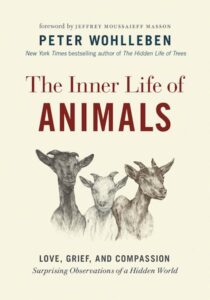It was when I took up walking in the very early mornings in order to improve my health that I came to better understand the local deer. Columbia Blacktails, Odocoileus hemionus columbianus, are abundant around our Pacific Northwest home, being particularly visible in the hours just before and after sunrise. Each day, as I set out on my pre-dawn hike, I never had to go far before meeting up with one (or two, or three…) just beside the road. Initially, they spooked and fled immediately upon seeing me – or more likely smelling me as my most common sight of them was an upraised tail speeding off into the trees. However after a few weeks, I began to take their own perspective more to heart and altered my behavior accordingly.
Whenever I saw one (who hadn’t yet turned and – literally – high-tailed it away), I would slowly nod my head, put my right hand over my chest in greeting, and – most importantly – not break my stride or make further eye-contact with them as I passed. Slowly, I noticed that they ceased to run as far away; then not to run at all. Even does with fawns stopped fleeing from me. I had done all I could to make it clear that I was not a threat – and, so long as I minded my newly adopted manners, they had apparently come to no longer see me as one.
Now, since reading Peter Wohlleben’s The Inner Life of Animals, I have been giving even greater thought to questions of what goes on in the minds of a wide variety of the creatures with whom we share this planet. Since childhood I have generally (rural teen-age boyhood isn’t always conducive to compassion or reflectiveness) been one who has seen non-human animals as much more than simply instinct-driven beasts; however a sojourn through the observations of, stories about, and insights into, as S. J. Tucker so poetically calls them, all our “friends of wing and tail” has opened up my mind to far more expansive – and indeed often breath-taking – vistas of thought about their cognitive and emotional lives.
The second book in his now world-renowned The Mysteries of Nature Trilogy, building squarely upon the engaging, story-teller style that was so effective in his earlier book The Hidden Life of Trees, The Inner Life of Animals guides the reader into expressions of shame in horses, fair-play in dogs, empathy in pigs, crows simply amusing themselves, and a host of other creatures exhibiting evidence of a wide range of cognitive and emotional states.
Admittedly, just as there were when Herr Wohlleben’s first volume in the series was published, there will be those who assert that there is too much anthropomorphism in this second book; however other than when recounting his own direct observations of non-human animals, all the information he presents is well documented with source citations. And indeed, as explanations of emotions even within our own species can be tricky as (and here we take a short swim into the deep end of the pool) we have no iron-clad way of knowing if other humans experience mental states absolutely identical to our own, the narrative creation of human-oriented metaphors to convey how a wood mouse experiences empathy is entirely understandable if the end result of conveying the idea is accomplished.
Then there is the ethical challenge of just what it means if the non-human animals that many of us (including myself) regularly, or even occasionally, eat experience psychological states similar to our own? For those not particularly keen on engaging in such reflections, it should be noted that Herr Wohlleben doesn’t touch upon such matters often in the text or belabor them when he does. However for all who do wish to pursue such lines of further thought, there is certainly much in the book that can be incorporated into such cogitations.
Taken as the continuation of his previous The Hidden Life of Trees, The Inner Life of Animals is a natural next step farther into the ideas of an author who has become one of the world’s most eloquent and publicly visible spokespeople for deep ecology. Taken unto itself, it is a very well-written and thought-provoking book for anyone interested in learning more about the mental worlds of our non-human animal neighbors. It is also strongly recommended to all those engaged in the various fields involving animal study, as well as those whose spiritual lives encompass circles larger than humans alone. As one who falls into all of these categories, I enjoyed it immensely for the fascinating information I discovered in it, the observational techniques I learned from it, and the less clearly definable but none-the-less deeply meaningful enlargement of my metaphysical perspective upon the planet and the many forms of life with which we all share it.
 Title: The Inner Life of Animals; Love, Grief, and Compassion—Surprising Observations of a Hidden World
Title: The Inner Life of Animals; Love, Grief, and Compassion—Surprising Observations of a Hidden World
Author: Peter Wohlleben; foreword by Jeffrey Moussaieff Masson, translated from the original German by Jane Billinghurst
Publisher: Greystone Books
Pages: 288 pp.
ISBN: 9781771643016
Published: November 2017
Original edition:
Title: Das Seelenleben der Tiere: Liebe, Trauer, Mitgefühl – erstaunliche Einblicke in eine verborgene Welt
Publisher: Ludvig Verlag (Random House GmbH)
Published: June 2016
In accordance with Federal Trade Commission 16 CFR Part 255, it is disclosed that the copy of the book read in order to produce this review was provided gratis to the reviewer by the publisher.
If you enjoyed reading this, please consider signing up for The Well-read Naturalist's newsletter. You'll receive a helpful list of recently published reviews, short essays, and notes about books in your e-mail inbox once each fortnight.
